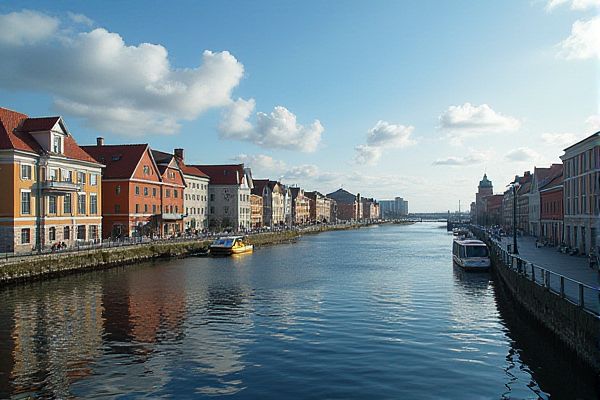
Weather and climate in Finland: Cold winters, mild summers. Northern lights visible in Lapland. Snow covers ground half the year. Mediterranean climate not present. Long winter nights, summer midnight sun. Rainfall evenly distributed annually. Southern regions warmer than north. Coastal areas have milder climate. Winter temperatures can drop below -30degC. Quick weather changes common.
Cold winters, mild summers.
Finland experiences cold winters, with temperatures often dropping to -4°F (-20°C) in northern Lapland, and mild summers, where temperatures can rise to 68°F (20°C) or more, especially in the south and east of the country. For more detailed information about the country's climate, you can visit the TripReport website. The contrast in temperatures provides a unique experience as the winter months are dominated by snow and ice, creating picturesque landscapes, while the summers bring a burst of life with lush greenery and long daylight hours in a stunning display of Finland's natural beauty.
Northern lights visible in Lapland.
The Northern Lights are best visible in Lapland, Finland, from September to March, with optimal viewing times in September, October, November, and February to March due to darker skies and increased solar activity. For those planning a visit, the [Northern Lights Lapland Guide](https://www.lapland.fi/visit/things-to-do/northern-lights-lapland-guide-aurora-borealis/) offers invaluable information on maximizing your chances of witnessing this breathtaking phenomenon. Clear skies and cold winter nights, especially between 9pm and 1am, enhance the chances of seeing the auroras.
Snow covers ground half the year.
The climate in Finland is characterized by its lengthy snowy season, where the ground remains blanketed in snow for nearly half of the year. In the southern regions, snow cover typically lasts for about three to four months, while in the northern areas, such as Lapland, the snow can persist for approximately seven months. For more in-depth information on Finland's unique climate, you can visit the detailed overview provided by Wikipedia.
Mediterranean climate not present.
Finland's climate is characterized by a mix of maritime and continental influences, classified under the Koppen climate classification as Df, indicative of continental subarctic or boreal climates. There is no presence of a Mediterranean climate due to its northern latitude and the dominant effects of the Atlantic Ocean and Eurasian continent. For more detailed insights, you can explore the Climate of Finland on Wikipedia, which provides extensive information on the factors influencing its unique climate characteristics.
Long winter nights, summer midnight sun.
In Finland, the climate is characterized by long winter nights, with winter lasting from early October to mid-May in northern areas and about three to four months in the south. However, summer brings the Midnight Sun, where the sun remains above the horizon for over 70 days in the northernmost parts of Finnish Lapland, particularly from June to July.
Rainfall evenly distributed annually.
In Finland, rainfall is relatively evenly distributed throughout the year, with the driest month being March and precipitation gradually increasing until July and August, or until September and October on the coast, before decreasing again towards winter and spring. For more information on the impact of climate patterns in Finland, you can explore the detailed insights provided on the Climate Change Post website.
Southern regions warmer than north.
In Finland, the southern regions are significantly warmer than the northern areas, with the warmest annual average temperature in Southwestern Finland being around 6.5°C (43.7°F). As one travels towards the north and east, the temperatures gradually decrease, reaching lows of 0 to -4°C (32 to 25°F) in northeastern Lapland. For more detailed information, the Climate of Finland varies extensively due to its geographical location and topography, influencing the way of life and environment across the country.
Coastal areas have milder climate.
Finland's coastal areas, such as the Southern and Western Coastal Climate Zones, have a milder climate due to the moderating effects of the Baltic Sea and the Gulf of Bothnia, characterized by mild winters and warm summers with significant rainfall throughout the year. These regions, including cities like Helsinki and Vaasa, benefit from maritime influences that keep temperatures relatively warmer compared to other parts of Finland. For more detailed climate information, you can explore the diverse Climate Zones of Finland and understand the different climate regions of Finland.
Winter temperatures can drop below -30°C.
Winter temperatures in Finland can drop significantly, with temperatures in Lapland often reaching -40°C to -45°C, and in southern areas like Helsinki, temperatures can hover around -10°C to -20°C, with January being the coldest month. Discover more about the wonders of Finnish winters by visiting the JoinMyTrip Blog, where you can explore in-depth information about this chilly Scandinavian experience.
Quick weather changes common.
Finland experiences significant variability in its weather, with quick changes common due to its location between the Atlantic Ocean and the Eurasian continent. This geographical positioning leads to influences from both maritime and continental climate systems, and frequent low-pressure areas cause variations in wind speed and direction. Additionally, climate change is exacerbating these fluctuations, with more frequent extreme weather events such as heavy precipitation and temperature records being broken. For more detailed insights, you can visit the Climate of Finland page on Wikipedia.
